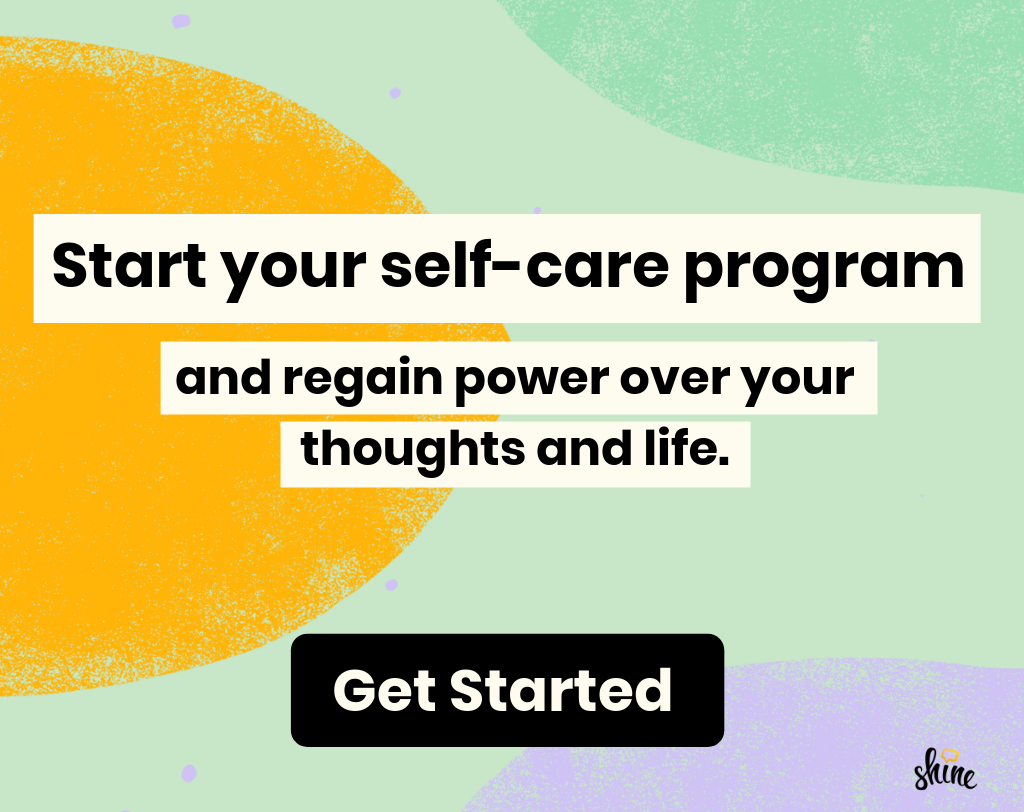Struggling to Name How You Feel? Try Using This Wheel
If you’re happy and you know it, clap your hands.
It seemed easy enough as a child, but age lets us in on a secret: naming your emotions as you feel them can be seriously tricky.
We feel hot bursts of...something, and react accordingly.
We stomp our feet, lean in for a kiss, lash out, retreat, cry, make rash decisions—all driven by emotions we don’t understand. We know that we’re experiencing something, but we can’t identify what it is until later, if at all.
If you've struggled with IDing your emotions, you're far from alone.
“(Identifying your emotions) sounds simple, but it's not,” Amelia Aldao, Ph.D., a licensed clinical psychologist, tells Shine. “We see this time and again, that people are pretty bad at identifying how they're feeling.”
Part of the problem, she explains, is that we’re rarely feeling one emotion at once. “You feel happy, but a bit scared. Sad and also angry,” she says. “It's not so simple to know what you're feeling.”
It’s not simple, but it is important.
Understanding what you’re feeling at a given moment can help you to make better decisions, move through uncomfortable emotions, and prevent some of those bad feels in the future. “Having a good sense of what you're feeling needs to be the starting point,” she says. “Otherwise, it's like playing a sport without knowing where the goal is.”
Understanding what you’re feeling at a given moment can help you move through uncomfortable emotions.
Humans have documented differences in their natural abilities to identify what they’re feeling, which means IDing your emotions might be a breeze for you—but nearly impossible for your partner. Still, Aldao says, “everyone needs a bit of help, to take a step back and say, 'What are all the thoughts going through my head?'”
For guidance, look to this wheel.
Are you familiar with the #feelings wheel? This week's challenge: try a new way to describe how you're feeling - either based on this wheel or a word that comes to you because of it. pic.twitter.com/mK3FHvR1iI
— Stephanie Ghoston Paul (@CultivatedSense) July 21, 2019
Tweeted by Stephanie Ghoston Paul, it breaks down dozens of emotions you might be experiencing and helps you hone in on your feel du jour.
Here’s how to make it work for you.
Pick an Emotion, Any Emotion
The next time you feel an emotion creeping over you, look at the options at the center of the wheel: fearful, angry, disgusted, sad, happy, surprised, bad.
Which seems to best encapsulate what you’re experiencing at the moment?
It may—and likely will—be more than one (ever felt shocked by a friend’s betrayal, angry at yourself for failing to see it coming, and sad at the loss of a friend—all at once?) so feel free to go down multiple paths.
Once you’ve settled on a chunk/emotion or two, look at the terms that come lumped with that umbrella emotion.
Say you’ve settled on “surprised.” Are you excited or amazed? Or feeling more startled and confused? Again, there’s often a mix of emotions, but pick the one that’s coming through the strongest.
From there, each secondary emotion is split into two even more specific terms.
If you’re excited, perhaps you’re eager or energetic. Feeling startled? You might define your core feeling as shocked or dismayed.
Work your way from the obvious to the nuanced, landing on the emotion that best describes the feeling currently overtaking your body and mind.
Think About the Word(s) You’ve Identified
Now that you can describe what you’re experiencing, really break it down.
What does that confusion feel like? Is it making your stomach turn or your fists clench? Is it leading to negative thoughts, urging you to pull back from the world or lash out at people you trust?
You might try journaling about it, or talking your feelings through with a friend.
Reframe the Situation
Once you understand what you’re feeling, it’s time to dig into why you’re feeling that way—and how to change it.
“Say I'm angry at my friend but feeling a little sad—I can begin to think of this differently,” Aldao says. If your pal kept you waiting for a dinner date, for example, “maybe they weren't trying to do something mean, they were late for another reason.”
Naming your emotions removes some of that initial heat and lets you see things a little more rationally—and with more room for forgiveness.
Naming your emotions removes some of that initial heat and lets you see things a little more rationally—and with more room for forgiveness.
Plus, if you bring up what you’re experiencing with your friend, you’re more likely to make your point without letting your emotions get the better of you.
Accept Your Emotions
“Some emotions aren't pleasant, but we make it worse by trying to fight them off,” Aldao says.
Whatever you're feeling, try to accept the emotion without judgment.
Feeling embarrassed by a recent outburst? Owning your feelings can help you move on—and stay in check the next time you’re upset. If you’re feeling dejected or overwhelmed by a work project, recognizing how you’re feeling might make you more likely to ask for help.
Use Your Feels as a Motivator
Once you’ve thought through what you’re feeling and why, use that intel to move forward. “Emotions can be a sign that we really care about things,” Aldao says. “Maybe you're anxious about grad school or starting a new job, and you identify that you're nervous because it matters to you.”
Instead of shutting down or avoiding whatever’s causing those anxious feelings, she says, “(that awareness) helps you run to the emotion—to say, 'I'm going to do this because it's important to me.'”
It can work in the other direction, too—if you’ve been forcing something that just doesn’t feel right, recognizing those feelings of frustration and disappointment can help you realize it’s time to shut it down.
Make IDing Your Feelings a Habit
Want to get better about recognizing your emotions in real-time? “Practice” by setting a regular check-in with yourself.
You can log your mood daily in the Shine app, or with a nightly journaling session—whatever your preferred method, take time to notice how you’re feeling and how you felt earlier in the day.
How did those emotions impact the decisions you made? The way your body felt?
As with anything else, says Aldao, it’ll get easier the more work you put in. “It’s like a sport,” she says. “You have to practice!”
Main image via www.classtools.net
Read next: Why You Should Write Letters to Your Emotions—and How to Start
You're more than your stress and anxiety. Take back control using Shine's award-winning self-care program.

Shine is supported by members like you. When you buy through links on our site, we may earn an affiliate commission. See our affiliate disclosure for more info.



